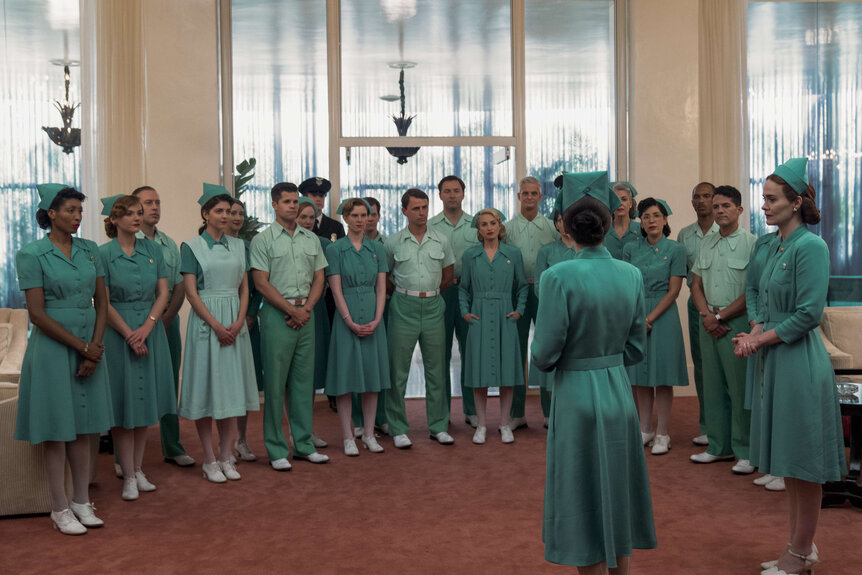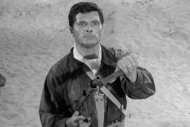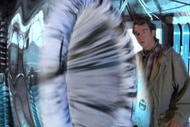Create a free profile to get unlimited access to exclusive videos, sweepstakes, and more!
How amazing costumes distract from Ratched's messy narrative

It is common for prolific creatives to repeatedly collaborate with talent both behind the scenes and in front of the camera. In the case of Ryan Murphy, he has a well established and ever-growing acting trope that has appeared in multiple projects crisscrossing the likes of American Horror Story, American Crime Story, and Hollywood. The content of these shows might not be to everyone's taste, but the names these projects attract cannot be denied. The same applies to Ratched, Murphy's latest offering as part of the gargantuan Netflix deal with Sarah Paulson in the titular role (Paulson also serves as an executive producer).
Paulson has been nominated for seven Emmys, six of which are from the Murphy library, and won in 2016 for ACS. Behind the scenes, costume designer Lou Eyrich has set an incredibly high bar across this long-standing partnership that goes back to Popular. She has received 14 Emmy nominations — two are as a producer — including five wins (a double for ACS). Eyrich co-designed Ratched with Rebecca Guzzi, who has previously assisted on AHS, Feud, and ACS (and won an Emmy for the latter in 2016). From the first color-soaked images released of the One Flew Over the Cuckoo's Nest origin story, it was clear the costumes would hit the lofty heights of Eyrich's previous work. Alas, incredible costumes cannot make up for narrative shortcomings, misguided plot developments, and clunky dialogue even if it draws our eye and distracts from the ensuing mess.
Spoilers for Ratched ahead.
Over the last 40-plus years, Nurse Ratched has been used as shorthand for the monstrous nurse archetype that has been a mainstay of horror and dramas set in a hospital location. She lacks the empathy associated with Florence Nightingale and will make your life misery — quite literally in the case of Stephen King's iconic character. As with Annie Wilkes in Castle Rock's second season, Mildred Ratched is now being given a deeper backstory that explores how she came to be.
Rather than the drab white uniform of the 1975 Oscar-winning One Flew Over the Cuckoo's Nest adaptation of Ken Kesey's 1962 novel of the same name, Ratched is dripping with bold color. Gone are the bleak walls of the Oregon State Hospital, replaced with vibrant mid-century wallpaper fit for a boutique hotel. Asylums in horror have long been a dank, dark, and horrifying location bathed in misery and torment — including Ryan Murphy's AHS: Asylum — so this is a noticeable shift in tone, which is part of an overtly stylized tapestry. While it might serve up some decor suggestions or send you on an Architectural Digest internet search, the vibrancy is just one misstep in a larger procession.
Set 16 years before the events in the novel, Ratched takes the opportunity to showcase how unregulated psychiatry was during this period, including experimental procedures that pushed patients toward further torment. A year before the plush Lucia State Hospital setting of the Netflix series, Life magazine's exposé on two US state hospitals had shocked the nation when it revealed the appalling conditions — so astonishing in degradation they were likened to the recently liberated concentration camps in Europe. Much like the heightened style and tone, the Ratched production design isn't striving for accuracy but the pretty floral pastel color scheme cannot cover the cracks of this origin story.
The glamorous setting and color-coordinated teal and seafoam nurses' uniforms are no doubt intended to serve as a juxtaposition to the horrors that occur within the walls of the Lucia State Hospital. If it was a private facility and Dr. Hanover wasn't scrambling for funds, this design choice would make way more sense. But like much of Ratched, the intent doesn't match the outcome. What we are left with is a mess of empty symbols and unfortunate metaphors that make this an Emperor's New Clothes affair. Pretty clothes prop up the illusion but cannot make up for a muddled backstory that relies on basic tropes.
Costume design is a language that adds texture to the misé-en-scene, but it shouldn't do all the heavy lifting. Symbolic color choices are woven throughout by Eyrich and Guzzi, including repeat shades of green to draw your eye. Guzzi told Fashionista this was to emphasize elements of "violence, oppression, lust, envy, greed, and evil." If you are unclear the mood is shifting whenever this clothing accent appears, it's fine because the lighting scheme will gladly bash you over the head. Similarly, flashbacks are utilized to reveal certain important experiences but are later retold, which suggests the writing isn't confident in its execution. In this case, the costume design has done the job and the lighting scheme is superfluous. Subtlety isn't in Murphy's wheelhouse, but Ratched needlessly cranks it up a notch.
Mildred's scam artist status is portrayed early on when she steals a beautiful mustard ensemble from a department store that resembles the iconic Dior "Bar" suit — Dior's defining New Look debuted in 1947. Faking her way into an interview and subsequently scoring the job that will reunite her with her murderous brother is an early indication that she is not as qualified as she appears to be. The U.S. Army Nurse Corps pin she wears on her suit is a purposeful nod to the movie, which doubles down on the "appearances are deceptive" theme that runs throughout Ratched. A closet packed full of exquisite garments can hide a multitude of sins, including qualifications you don't possess. They sadly cannot cover up empty and wildly erratic characterization.
Other than a few superficial nods, such as Mildred's hairstyle and a horrifying death in the first episode, there are few references to the Miloš Forman directed 1975 film. Sarah Paulson's performance bears little similarity to Louise Fletcher's Oscar-winning turn as the infamous nurse, which wouldn't be an issue if the writing matched her talents. This purposeful direction draws a distinct line between the two, allowing for this stylistic exploration but never really justifying these choices beyond the surface level shock and awe.
Instead of Forman, it is Alfred Hitchcock's fingerprints that have left their mark on the aesthetic, including the penchant for color-coded costuming. Hitchcock also had a fruitful collaboration with a costume designer, working with the legendary Edith Head on 11 movies. As with Ratched, green is an important color in the Head designed Vertigo and The Birds. The latter takes the earthy approach, whereas Kim Novak's dress is to conceal.
The project Ratched most resembles is American Horror Story, which shouldn't be surprising knowing who the showrunner is — Murphy shares co-creator status with newcomer Evan Romansky. The revenge subplot involving Sharon Stone as the bloodthirsty Lenore Osgood who has oodles of cash to burn to get her decapitated doctor wish is straight out of the AHS playbook. Meanwhile, her costumes good enough to appear in the alt-universe Hollywood (designed by Sarah Evelyn).
Lenore's penchant for white attire was always destined to be ruined by blood, but she serves up look after look before her violent demise. She also has a couture wearing pet monkey who she leaves half her fortune to — this tells you everything you need to know about this character's erratic bond with her son.
In fact, a costume nod to Paulson's Asylum character, journalist Lana Winters — who also scams her way into the facility under false pretenses — is featured in the first scene. The red R pin (see above) is a direct nod to Lana's L lapel pin, which is an Easter egg for fans of this character. It also reads like a suggestion that both shows take place in the same universe. The actions of Edmund Tolleson in Ratched (including the homage to nurse killer Richard Speck in the season finale) lean into the strong AHS vibe that is impossible to ignore. It would make way more narrative sense if this was a prequel to Asylum rather than One Flew Over the Cuckoo's Nest. Unfortunately, this costume detail is little more than a reminder of Murphy's longest-running series that also features award-winning costume designer highlights galore (and also have a tendency to go off the rails).
The masterful work of designers like Lou Eyrich and Rebecca Guzzi can still be admired and celebrated even when the production is as disappointing as Ratched is. But it is also worth noting that while costume can elevate the material, it also cannot dress up an origin story as misguided as this one.
































